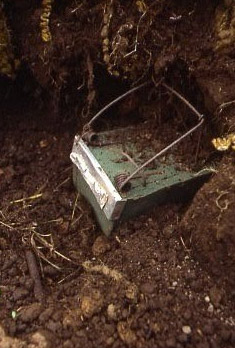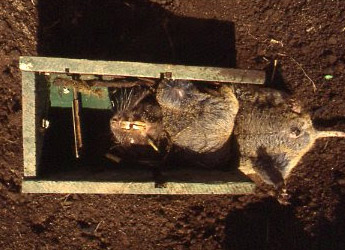 |
 |
Even though it's late summer, the little ground rats are taking down some of my plants.
I’ve had good results with the “California box trap”. I think the box trap is easier to use if you’ve never set gopher traps before. The box trap in the photo here shows the installation, but the trigger has been activated – see the wire in the up position. [The gopher from the same trap pictured above would fill the entire box!]
To set the box traps, locate the main tunnel with a probe. I use a 24” piece of rebar. The permanent or main burrow [as opposed to the feeding runs] can be found by probing about eight to 12 inches from the plug side of the visible mound and is usually located six to 12 inches deep. When the probe penetrates the gopher’s burrow, there will be a sudden, noticeable drop of about two inches. You may have to probe repeatedly to locate the gopher’s main burrow, but your skill will improve with experience.
Use a shovel or garden trowel to open the tunnel wide enough to set traps in pairs facing opposite directions. By placing traps with their openings facing in opposite directions, a gopher coming from either end of the burrow can be intercepted.
Box traps are especially useful when the diameter of the gopher’s main burrow is small (less than three inches.)
Some claim it is a good idea to use lettuce, carrots, apples, alfalfa greens, or a drop of anise oil as bait. I rub all surfaces I’ve touched with grass or weeds and be sure to rub the trap trigger. [Or, use hospital disposable gloves.] Then I leave a piece of grass or whatever then it has been eating behind the trap’s wire.
After setting the traps, exclude light from the burrow by covering the opening with dirt clods, sod, cardboard, or some other material. Fine soil can be sifted around the edges to ensure a light-tight seal. If too much light enters, the gopher may plug the burrow with soil, filling the traps and making them ineffective. I place a large piece of plywood or cardboard over the entire “excavation” to make sure no light gets through.
The theory is that the gopher feels the flow of air and wants to plug the breach of the tunnel system. The gopher runs through the tunnel and is in the box before it knows it because the flashing on top of the box excludes light but allows air to escape.
Check traps often and reset them when necessary. If a gopher is not caught within 24 hours, reset the traps in a different location.
|

